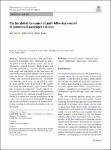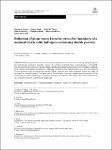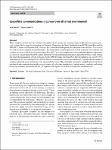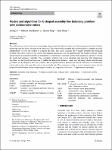Search
Author
- Amir, Ebrahimi (2)
- Aydin, Azizi (2)
- George, Haller (2)
- James, M. Fiore (2)
- next >
Subject
- robotics (9)
- Engineering (8)
- engineering (8)
- công nghệ (3)
- next >
Date issued
- 2020 - 2023 (215)
- 2010 - 2019 (28)
- 2001 - 2009 (6)
Has File(s)
- true (249)
Search Results
Control-based continuation (CBC) is an experimental method that can reveal stable and unstable dynamics of physical systems. It extends the path-following principles of numerical continuation to experiments and provides systematic dynamical analyses without the need for mathematical modelling. CBC has seen considerable success in studying the bifurcation structure of mechanical systems. Nevertheless, the method is not practical for studying relaxation oscillations. Large numbers of Fourier modes are required to describe them, and the length of the experiment significantly increases when many Fourier modes are used, as the system must be run to convergence many times. Furthermore, relaxation oscillations often arise in autonomous systems, for which an appropriate phase constraint is ... |
We present a fast method for nonlinear data-driven model reduction of dynamical systems onto their slowest nonresonant spectral submanifolds (SSMs). While the recently proposed reduced-order modeling method SSMLearn uses implicit optimization to fit a spectral submanifold to data and reduce the dynamics to a normal form, here, we reformulate these tasks as explicit problems under certain simplifying assumptions. In addition, we provide a novel method for timelag selection when delay-embedding signals from multimodal systems. We show that our alternative approach to data-driven SSM construction yields accurate and sparse rigorous models for essentially nonlinear (or non-linearizable) dynamics on both numerical and experimental datasets. |
The nonlinear dynamics of the path-following control of passenger cars is analyzed in this paper. The effect of specific modeling aspects, such as tire deformation, steering dynamics, feedback delay and controller saturation, is considered. Possible equilibrium points and singularities in the state space are uncovered and analyzed for different vehicle model and controller designs. The equilibrium of stable path following is then analyzed in greater detail: The domains of stabilizing control gains are presented in stability charts and the basin of attraction of the equilibrium along the stable domain is approximated with the help of numerical continuation. Unsafe zones of control gains are highlighted, where the stable equilibrium is surrounded by low-amplitude unstable limit cycles... |
5G technology is intended to support three promising services with heterogeneous requirements: Ultra-Reliable and Low Latency Communication (uRLLC), enhanced Mobile Broadband (eMBB), and massive Machine Type Communication (mMTC). 6G is required to support even more challenging scenarios, including the presence of a large number of uRLLC devices, under the massive uRLLC (mURLLC) use case scenario. The presence of these services on the same network creates a challenging task of resource allocation to meet their diverse requirements. Given the critical nature of uRLLC applications, uRLLC traffic will always have the highest priority which causes a negative impact on the performance of other services. In this paper, the problem of uRLLC/eMBB resource allocation is investigated. |
Reflection phenomena of a set of coupled longitudinal waves/shear wave striking obliquely against the mechanically stress-free boundary surface of a uniform nonlocal elastic solid half-space with double porosity structure have been investigated. Employing the appropriate nonlocal stress-free boundary conditions at the surface, the formulae for reflection coefficients and their corresponding energy ratios have been derived for the dissipative and non-dissipative models. Their variations have been computed against the angle of incidence for a specific model. It is found that all the reflection coefficients depend upon the presence of the nonlocality, porosities of both types, frequency and angle of incidence. Their impact on various coefficients is also studied numerically and depicte... |
This is a high-level study into the validation of a unified electric power and communications architecture for modern spacecraft systems. We leverage from blending the European Cooperation for Space Standardisation (ECSS) SpaceWire and the IEEE 802.3 Power over Ethernet (PoE) standards for a common onboard power and communications interface. The focus of the work has been communication performance. The requirements from the protocols of both standards were analysed and combined to create a full protocol stack for SpaceWire PoE. The stack is implemented on an embedded platform represented as a proof-of-concept SpaceWire PoE system. The results of functional testing demonstrate SpaceWire PoE as a valid solution that meets the requirements of both protocols. For the 100 Mb/s links, the... |
In this study, timber column–sill joints strengthened with carbon fiber-reinforced plastic (CFRP) plates using bonds and screws were subjected to loading tests. Twelve joint specifications were considered depending on different combinations of the CFRP plate surface finish and thickness and the type of bond, and the corresponding effects on the load–displacement behavior of the joints were investigated. Three failure modes were observed in addition to the peeling of the CFRP plate. The specimens that failed owing to screw tear out and screw head pull-through in the CFRP plate or splitting of the sill showed load–displacement curves of a similar shape. |
The paper industry manufactures corrugated cardboard packaging, which is unassembled and stacked on pallets to be supplied to its customers. Human operators usually classify these pallets according to the physical features of the cardboard packaging. This process can be slow, causing congestion on the production line. To optimise the logistics of this process, we propose a visual recognition and tracking pipeline that monitors the palletised packaging while it is moving inside the factory on roller conveyors. Our pipeline has a two-stage architecture composed of Convolutional Neural Networks, one for oriented pallet detection and recognition, and another with which to track identified pallets. |
Since the nineteenth century, reinforced concrete was evolved as a crucial material for construction. This popular composite material is broadly used in different building typologies. However, the decaying of steel rebar due to corrosion is identified as a hindrance that can affect the quality of reinforced concrete structures. In reference to this, the glass fiber-reinforced polymer (GFRP) bar is essential because of corrosion-resistant properties. The researchers performed various tests and numerical analysis to know the response of GFRP-reinforced flexural members in shear and bending. Based on studies over the last decade, this study critically analyzes the response of flexural member reinforced using glass fiber-reinforced polymer (FRP) bars. Understanding the behavior of the F... |
The collaborative robots (cobots) are increasingly being utilized in industries due to the advancement in the field of robotic technology and also due to the increase in labor costs. The cobots on the assembly line can be utilized to complete the tasks independently or assist the workers to complete the tasks. This study considers the U-shaped assembly line balancing problem with cobots, where several cobots with different purchasing costs are selected under the budget constraint. Three mixed-integer programming models are formulated to optimize the cycle time, and the built models are capable of solving the small-sized instances optimally. |









